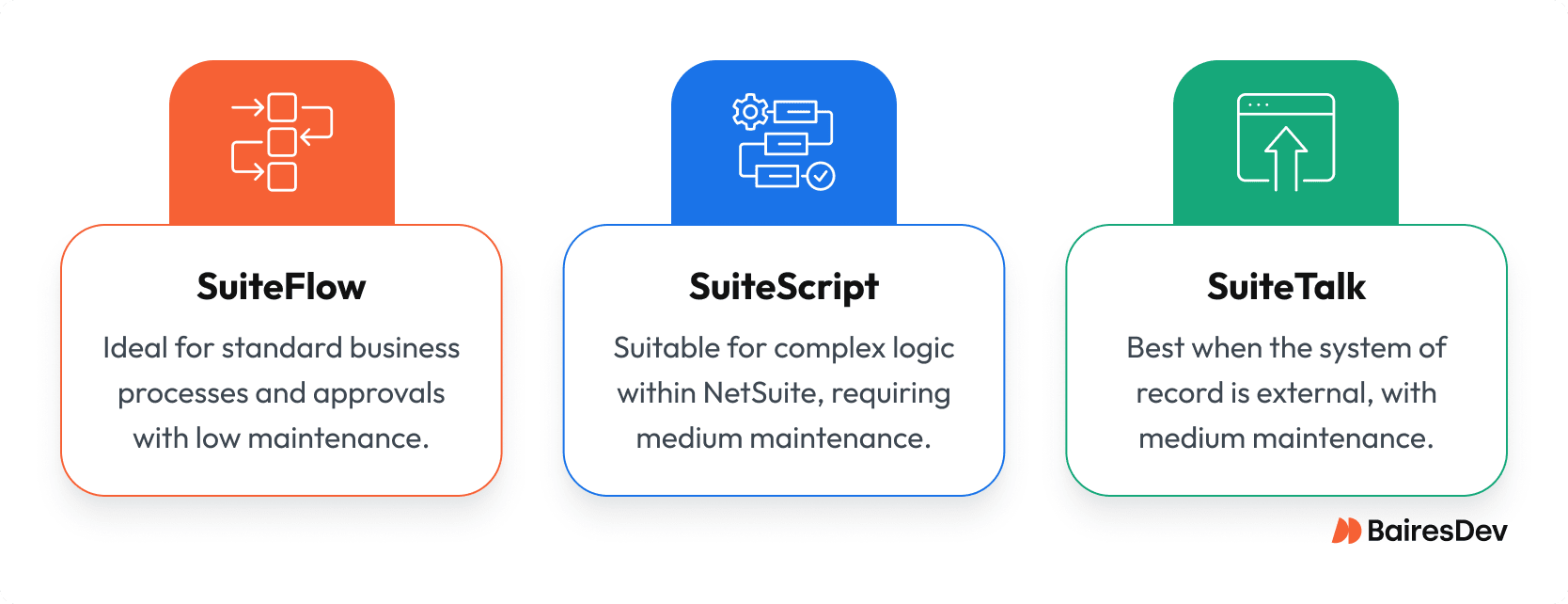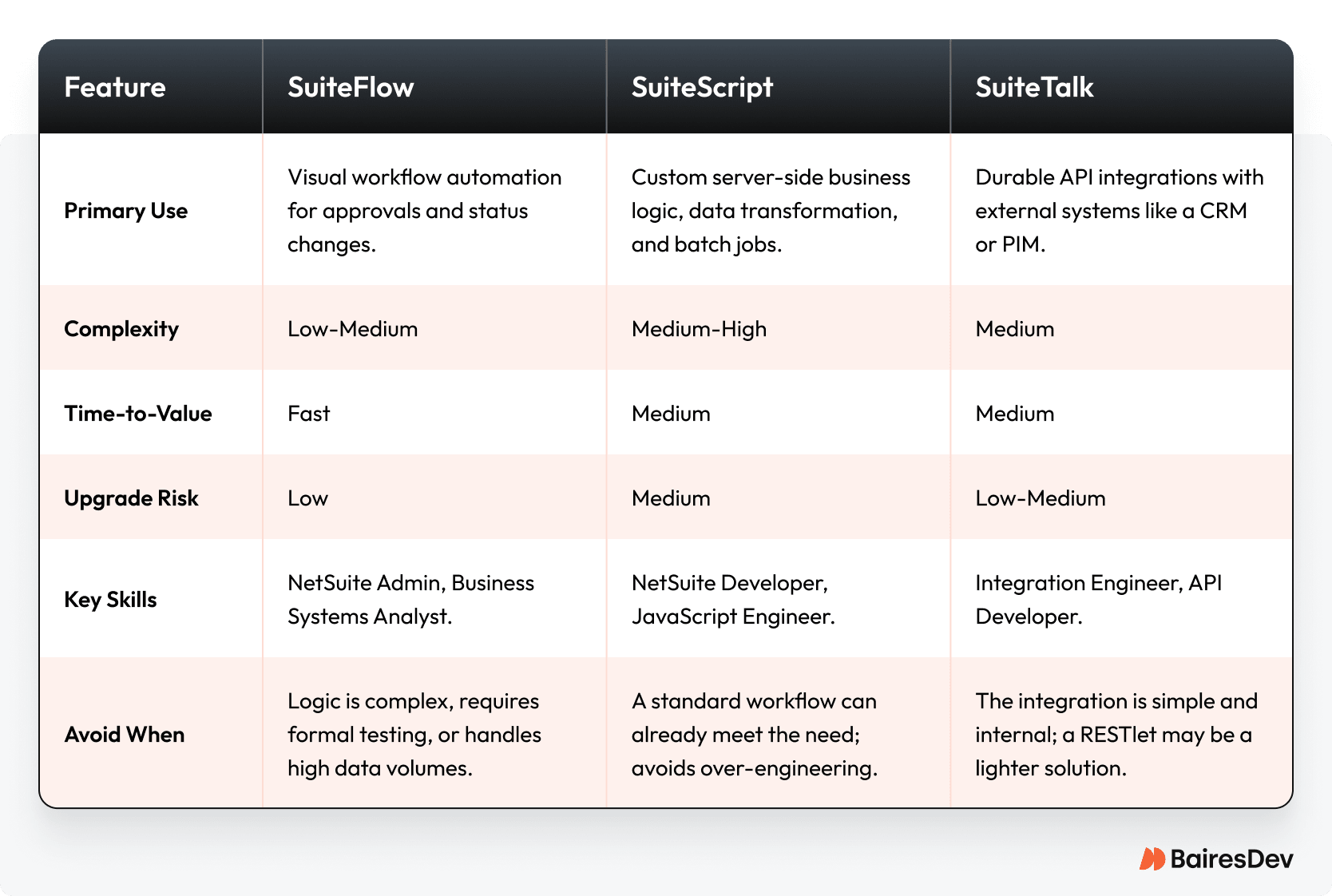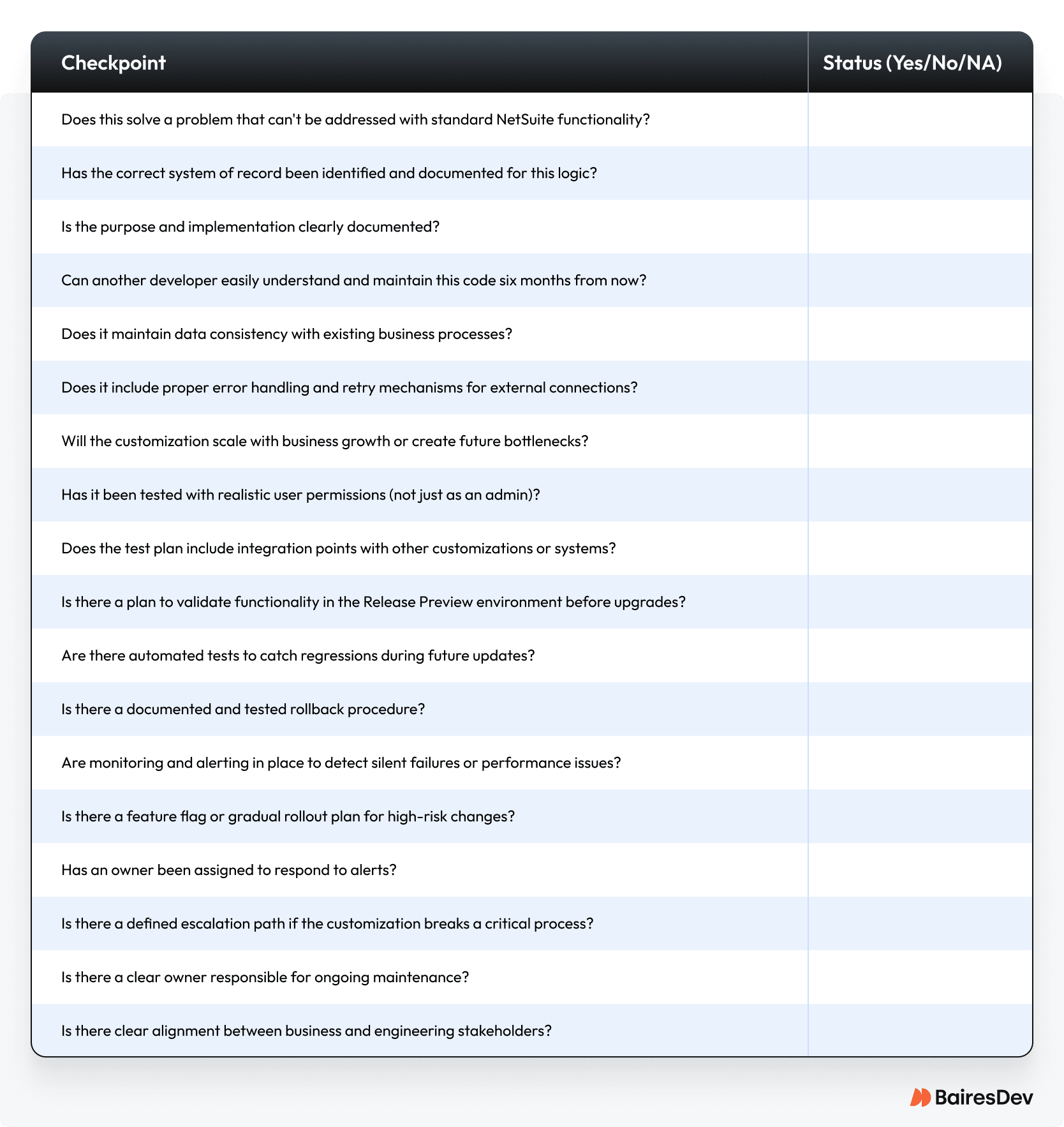Customizing NetSuite should speed up work, not add risk. A lot of NetSuite instances are a chaotic mix of undocumented custom scripts, consultant-written workflows, and brittle integrations that no one on your engineering team actually owns. It’s treated like a simple business application, but it fails like a critical production system—usually during month-end close.
This article provides the framework to stop the chaos, and a convenient checklist drawn up by our NetSuite customization experts. We will demonstrate how to make good architectural choices when you tailor NetSuite to your needs, and how to apply good governance. The goal is to turn NetSuite into a stable, strategic asset and prevent it from becoming a source of friction.
Engineering Maintainable NetSuite Customizations
Let’s start with the obvious. Design NetSuite customizations like production systems. Choose the lightest layer that meets the requirement, keep boundaries clear, and plan for upgrades. Done well, architecture decisions reduce blast radius, shorten release cycles, and turn ERP system changes into repeatable engineering work instead of one-off fixes.
NetSuite’s SuiteCloud platform separates concerns. Data modeling happens through configuration. Workflow orchestration lives at the workflow layer. Business logic runs in scripts. External integration uses formal APIs. The goal is to treat each layer as a boundary so changes stay easier to reason about, test, and reverse.

Understanding SuiteCloud layers helps you match the solution to the problem and shape risk. Surface configuration through SuiteBuilder, such as field additions and form layouts, typically rides upgrades with minimal effort. Workflow automation through SuiteFlow speeds simple approvals and routing without code. These choices are fast to ship and generally low-maintenance.
Use SuiteScript when domain rules require calculations, validations, or record transformations that configuration cannot express. Keep logic server-side, instrument it, and test with realistic data. Use SuiteTalk integration APIs when the system of record resides outside NetSuite or when you require durable, contract-first data exchange.
Architecture sets operational cost. Clear interfaces between configuration, scripts, and integrations keep deployments predictable and rollbacks straightforward. Blurring layers, embedding business rules in clients, or copying data across systems increases coupling and upgrade risk.
NetSuite Customization Comparison: SuiteScript vs SuiteFlow vs SuiteTalk

Why NetSuite Customization Needs Engineering Governance
Engineering governance prevents brittle customizations by adding ownership, reviews, and rollback plans to the same workflows you trust for product code.
Most teams experience NetSuite implementation problems the hard way. A release fails because two groups scripted the same sales flow differently. An upgrade breaks billing logic with no owner or test. These are production failures in a critical business system.
The root cause is organizational. When NetSuite consultants or business teams ship changes without engineering oversight, overlaps and hidden dependencies pile up. Code that worked for month-end collapses under real permissions, real data, and real load.
Governance fixes the pattern. Put NetSuite in source control. Require design reviews for flows and scripts. Define owners. Ship with tests and a documented rollback. If it can stop invoicing or reporting, it deserves the same rigor as your core platform.
Customization and Downstream Impact on Engineering Teams
Ungoverned NetSuite work creates incidents and slows product delivery. Apply the same guardrails you use for product code so small gaps do not become fire drills.
- Version control: All SuiteFlow definitions and SuiteScript live in a repo, not only inside NetSuite. The SuiteCloud Development Framework (SDF) supports engineering governance with version control and scripted deployment.
- Tests that matter: Validate permissions, record transitions, and data integrity on realistic sample data.
- Rollback you can trust: One command or a documented procedure to disable a flow, revert a script, and restore service.
Version Control and Development Workflow
Put NetSuite work in source control and use the same workflow you trust for product code. Your projects live in Git repositories, with changes flowing through branches and pull requests. Every deployment is tied to a ticket, a reviewer, and a rollback plan.
- Repository and structure: Store SuiteScript, SuiteFlow workflow XML, custom objects, and project files such as manifest.xml and deploy.xml in the SDF project. Keep code, configuration, and docs together.
- Branching: Create short-lived branches per ticket. Require at least one reviewer and passing checks before merging.
- Conflict prevention: Assign object ownership, track touched record types in the ticket, and review Git diffs of XML and script changes before merging. Coordinate when multiple teams affect the same object.
- Environment promotion: Build in a development sandbox, integrate in a UAT or staging sandbox with realistic data, and promote to production only after validation and sign-off. Tag releases in Git.
- Automation: In continuous integration, run SuiteCloud CLI validate, linting, unit tests, and a smoke deploy to your UAT sandbox. Block production jobs if checks fail, then deploy with SuiteCloud CLI when ready.
For examples and SuiteCloud customization best practices, see Oracle’s official SuiteCloud sample code repository.
Testing Strategies for ERP Customizations
Test the rule, the flow, the permissions, and the data. Your goal is not only to have working code, but also to have working business processes under real-world roles and real load.
- Unit tests: Exercise SuiteScript logic in isolation. Use SuiteCloud Unit Testing with Jest and SuiteCloud CLI to validate calculations, date rules, field mappings, and error paths.
- Integration tests: Prove that customizations interact correctly with NetSuite features and external services. Verify saved searches, transforms, and safe retry behavior for integrations.
- Role-based testing: Run scenarios as Sales Rep, AR Clerk, Controller, and Administrator to confirm least privilege and correct error handling. NetSuite advises testing with specific roles and provides permission reference materials.
- Data integrity checks: Assert totals, rounding, currency conversions, time zones, and effective dates using production-like datasets.
- Upgrade validation: After each NetSuite release, rerun a smoke pack of critical flows in the Release Preview environment and track deprecations. Scheduled scripts do not run automatically in Release Preview, so plan manual tests or use a sandbox for automation.
- Test data: Use a golden dataset with masked PII and refresh sandboxes on a regular cadence so tests reflect production.
Deployment and Release Management
Deployments should be predictable, observable, and reversible. Plan change windows, ship small, and practice recovery so incidents become routine, not chaotic.
- Feature flags: Use script parameters to control rollout and enable rapid disablement.
- Release timing: Avoid month-end and peak sales periods. Announce windows and freeze risky changes ahead of time.
- Preflight checks: Validate dependencies, permissions, saved search performance, and expected governance unit budgets before approving a release. NetSuite documents SuiteScript governance and provides tools to analyze search performance.
- Monitoring and alerts: Track error rates, execution times, retry queues, and integration health. The Application Performance Management SuiteApp provides dashboards for scripts, searches, processors, and web services.
- Rollback: Maintain a last known good tag and a documented procedure to quickly disable a flow or revert a script, including the owner, approval path, and any necessary details.
- Documentation: Maintain a deployment checklist, release notes, and escalation contacts. Store everything with the code so responders can act fast.
The Strategic Framework: Configure, Customize, or Integrate
Engineering leaders face three options for every NetSuite customization requirement: native configuration, custom development, or external integration. The wrong choice creates maintenance and upgrade risk, so decide based on technical complexity and long-term fit.
- Configuration first: Use NetSuite’s native functionality when it meets requirements without significant compromise. SuiteBuilder handles custom fields, forms, and records. SuiteFlow automates straightforward approvals and state changes. SuiteAnalytics saves searches, surfacing data without code. These approaches are easy to upgrade and require minimal maintenance.
- Long-term business logic: Complex calculations, industry-specific rules, or approval processes that truly belong in NetSuite justify custom development. SuiteScript supports server-side business logic and record processing, making these rules testable and easier to govern over time. Ask whether the logic will still be relevant in three years.
- Integrate when truth lives elsewhere: Decide and document the system of record, then sync only what NetSuite needs. Customer profiles may reside in a CRM, product data may live in a PIM or inventory system, and financial status typically sits in an ERP. Use SuiteTalk REST or SOAP to exchange data reliably and maintain authoritative sources.
Prioritize reversible decisions. Configuration reverses easily. Well-bounded customizations are manageable to unwind, while deep business logic embedded broadly in scripts creates tight coupling and makes rollbacks more challenging. Apply the same SDLC rigor and versioning you use elsewhere to keep options open.
NetSuite Customization Team Management
Unclear boundaries and ad hoc requests sink projects. Define who owns business rules, who owns technical implementation, and how work flows from intake to release to reduce context switching and prevent customization chaos.
Ownership Boundaries and Decision Authority
Set clear boundaries. The business defines what they need out of NetSuite and why. Engineering defines how and when the customization is shipped. This philosophy prevents unrealistic promises, risky exceptions, and last-minute surprises.
- Business logic ownership: Finance and operations specify outcomes. Engineering determines technical implementation.
- Data integrity responsibility: Engineering owns validations and integration patterns, even when exceptions are requested.
- Change request prioritization: The business ranks value and urgency. Engineering assesses feasibility and allocates capacity.
- Production deployment authority: Engineering approves when and how releases occur to protect stability.
NetSuite Customization Request Protocols
A simple intake, combined with quick sizing, prevents rework and maintains stable priorities. Standard fields, regular check-ins, and clear escalation maintain realistic expectations.
- Standardized request form: Capture objective, success criteria, deadlines, record types touched, and required roles before work begins.
- Technical feasibility assessment: Provide early sizing and alternatives to inform business decisions before commitment.
- Regular check-ins: Time-boxed reviews keep scope aligned with priorities and constraints.
- Escalation path: Define who resolves conflicts between urgency and risk and how decisions are communicated.
Nearshore Team Integration Strategies for NetSuite Customization
Outsourcing NetSuite customization services to reputable vendors adds capacity when they share tools, rituals, and ownership. Align time zones for live reviews, assign clear domain areas, and require the same repos, tests, and release steps.
- Domain expertise assignment: Give nearshore teams long-term ownership of specific functional areas.
- Integrated development workflows: Use the same repositories, reviews, tests, and release steps across teams.
- Stakeholder relationship management: Allow nearshore leads to meet directly with finance and operations under agreed protocols.
- Knowledge transfer protocols: Document designs and run regular handoffs so knowledge is shared, not siloed.
Decision-Making Frameworks for Conflicting Requirements
When needs clash, choose stability and data truth first. Trade short-term convenience for long-term maintainability and weigh your local gains against the overall business impact.
- System reliability over feature velocity: Delay or alter requests that threaten stability.
- Data consistency over user convenience: Decline exceptions that weaken data truth or auditability.
- Maintainability over short-term savings: Prefer solutions that scale with fewer future fixes.
- Cross-functional impact assessment: Evaluate effects across units before approving broad changes.
NetSuite Customization Pitfalls That Create Downstream Failures
Minor missteps in NetSuite implementation often lead to cascading incidents, rework, and missed releases. Prevent issues before they reach month-end close or customer billing by treating these changes with production-grade discipline.
Customization Red Flags to Avoid
Some patterns create more support work than value. Use this list to spot fragile designs before they reach production:
- Updates: Avoid solutions that rely on manual record edits to maintain continuity of flow. Redesign with configuration records, parameters, or scheduled automation so behavior is data-driven.
- Compliance: Do not allow users to bypass required fields or approvals. Enforce server-side validations and maintain audit trails to protect segregation of duties.
- Logic: Avoid dependencies on undocumented behavior or specific field update sequences. Make dependencies explicit and add compatibility checks to survive releases.
- Integration: Avoid hard-coding system IDs or API endpoints. Use environment-specific configurations and discoverable identifiers for a smooth transition between sandbox and production environments.
Undocumented Scripts Breaking Upgrades
Scripts tied to hidden dependencies fail quietly after platform changes. Require documentation, ownership, and release testing so your upgrades do not disrupt business operations.
- Mandatory documentation standards: External and internal scripts must include business purpose, inputs, side effects, and dependency mapping before deployment.
- Code review requirements: Engineering reviews consultant work with the same checks as product code, verifying APIs used, record types touched, and error handling.
- Upgrade testing protocols: After each NetSuite Release Preview or sandbox refresh, run smoke tests on critical flows to identify compatibility issues before they reach production.
Finance-Led Workflows That Bypass Data Integrity
Shortcuts that skip validations speed up data entry today, but break reporting tomorrow. Guard the system of record and maintain auditable approvals.
- Technical review authority: Engineering holds final say on validations and integration rules, even when exceptions are requested.
- Impact assessment procedures: Evaluate workflow changes for data quality, auditability, and regulatory impact before approval.
- Alternative solution development: Offer designs that preserve validation, such as guided entry, queued approvals, or server-side checks.
Brittle Point-to-Point Integrations That Fail Silently
Tight couplings break when endpoints, auth, or formats change. Build for retries, visibility, and safe fallback so sync issues do not morph into outages.
- Comprehensive error handling: Include retries with backoff, timeouts, and structured error logging that pinpoints the failing step.
- Proactive monitoring systems: Alert teams to failed calls, backlogs, and unusual latency, so they can act before users experience the impact.
- Fallback procedures: Define manual or queued operations that keep critical work moving when dependencies are down.
- Integration health dashboards: Provide real-time status of jobs, queues, and last successful sync, with clear ownership for response.
NetSuite Customization Engineering Checklist
This checklist helps you evaluate customization readiness and identify potential failure points before deployment. Regularly reviewing these questions can help you avoid common NetSuite customization pitfalls that create operational overhead and system reliability issues.







